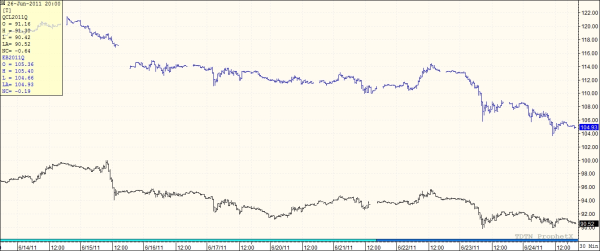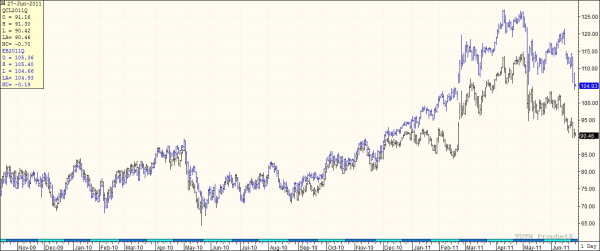Our Thoughts On The IEA Crude Oil Release
While we generally avoid commenting on news and politics, we thought the announcement from the the IEA last Thursday to release 60 million barrels of crude from reserves, 30 million which will come from the US SPR (Strategic Petroleum Reserve), deserves a few minutes of attention. As the following chart shows, the announcement did push WTI (black) and Brent (blue) prices lower, but prices actually began to decline a couple weeks before the IEA's announcement. That being said, let's look at the reality of the situation.

From the IEA's official announcement:
"The 28 IEA member countries have agreed to release 60 million barrels of oil in the coming month in response to the ongoing disruption of oil supplies from Libya. This supply disruption has been underway for some time and its effect has become more pronounced as it has continued. The normal seasonal increase in refiner demand expected for this summer will exacerbate the shortfall further. Greater tightness in the oil market threatens to undermine the fragile global economic recovery.
In deciding to take this collective action, IEA member countries agreed to make 2 million barrels of oil per day available from their emergency stocks over an initial period of 30 days. Leading up to this decision, the IEA has been in close consultation with major producing countries, as well as with key non-IEA importing countries.
The IEA estimates that the unrest in Libya had removed 132 mb of light, sweet crude oil from the market by the end of May. Although there are huge uncertainties, analysts generally agree that Libyan supplies will largely remain off the market for the rest of 2011. Given this loss and the seasonal increase in demand, the IEA warmly welcomes the announced intentions to increase production by major oil producing countries. As these production increases will inevitably take time and world economies are still recovering, the threat of a serious market tightening, particularly for some grades of oil, poses an immediate requirement for additional oil or products to be made available to the market. The IEA collective action is intended to complement expected increases in output by these producing countries, to help bridge the gap until sufficient additional oil from them reaches global markets.
“Today, for the third time in the history of the International Energy Agency, our member countries have decided to act together to ensure that adequate supplies of oil are available to the global market,” Mr. Tanaka said. “This decisive action demonstrates the IEA’s strong commitment to well-supplied markets and to ensuring a soft landing for world energy markets.”
Total oil stocks in IEA member countries amount to over 4.1 billion barrels, and nearly 1.6 billion barrels of this are public stocks held exclusively for emergency purposes. IEA net oil-importing countries have a legal obligation to hold emergency oil reserves equivalent to at least 90 days of net oil imports. These countries are holding stock levels well above this minimum amount, currently at 146 days of net imports."
This is reeks of political "manipulation" of the oil markets for so many different reasons...
- For starters, the unrest in Libya began in February. If the IEA's announcement was really a response to the decline in Libyan oil production, it should have occurred well before now. It simply doesn't take four months to come to a decision to release reserves of such a small quantity (see below for more on the quantity as it relates to global demand). Given the four month lag, the oil markets had largely already adjusted to the lost Libyan barrels.
- 2MM BPD (barrels per day)? According to EIA data, US crude oil demand (refiner net input in EIA terminology) alone has averaged roughly 14.5MM BPD over the past year. Similarly, US refined product demand (product supplied in EIA terminology) has averaged roughly 19.25MM BPD over the past year. Not to mention global demand, which, also according to the EIA, is about 84MM BPD. So the IEA release doesn't even meet 24 hours of global demand.
- Last but definitely not least, the"soft landing" language (fourth paragraph) should be the most telling part of the announcement. A soft landing is generally defined as the process of an economy shifting from growth to slow-growth to potentially flat, often influenced by government intervention. In our opinion, the inclusion of the "soft landing" phrase says that IEA members are concerned about the impact of "high" oil prices on an already weak global economy and that the release of reserves is more about attempting to push (manipulate) oil prices lower than providing the market with 2MM BPD for a single month. As the following chart shows, the bullish trend in both WTI and Brent began a year ago, not in the recent months.

As the previously mentioned data shows, the math simply doesn't add up. If the IEA really felt the need to provide the market with enough oil to compensate for lost Libyan output, they should have said that they were going to flood the market with barrels, (per their own announcement, their members have plenty of inventory), not a trickle of 60MM barrels over the course of a month.
So what does the IEA's announcement or the subsequent release of 60MM BPD mean as it relates to oil prices in the longer term? Only time will tell but 60MM barrels, spread out over the course of a month, simply aren't enough barrels to have a long term impact on the market. In the long run, actual supply and demand (or better said, the market's perception of supply and demand) determines the price of oil, not the IEA, nor any other political or governmental organization. At the end of the day, a physical barrel of oil is only worth what a buyer is willing and able to pay for it.
